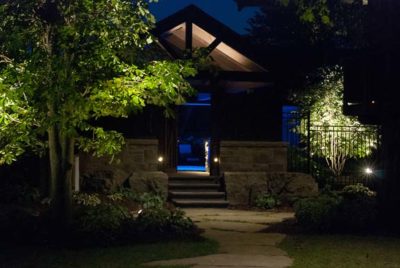Plants

To give the outdoor living space a cozy feel, the landscape was densely planted. McGregor prefers an organized look to landscaping and, thus, likes to plant in groupings that flow in uniformity.
It is important to pay attention to the foliage. For instance, to provide year-round colour, plant materials that bloom at various times throughout the year were considered. The foliage in this landscape project comprises a complementing combination of green sedum and hydrangea, lime-green spirea, plumb-red smoke bush and barberry, and fiery-red Japanese maple and blue spruce. By focusing on when the different plants are set to bloom, in addition to their scale, colour, and texture, the visual appeal of the gardens are heightened.
Lighting
Exterior lighting, like interior lighting, can make all the difference to any living space. That said, the advances in lighting technology have made it much easier for landscape designers/builders to illuminate outdoor spaces.
“In the past, landscapers had to worry about voltage drops (loss) with incandescent lights,” says McGregor. “But with the many light-emitting diode (LED) products now available, the consumer uses a lot less electricity to light up their property.”
Sixty different lights were installed for this project that, in the past, would have used 1000 watts of electricity, but today uses less than 100 watts. The objective for the lighting in this landscape was not only to provide enough illumination for the safety and usability of the space, but also to create layers of light that highlight every element of the landscape.
Decking
Knowing what type of deck materials to use and where to install them is important not only for functionality, but also esthetics. For instance, McGregor says he loves the versatility of stamped concrete, but prefers not to use it directly around the pool.
“Stamped concrete can sometimes become slippery; therefore, I prefer to use interlocking pavers/flagstone around the pool edge.”
Using pavers around a pool can provide additional safety and grip/slip-resistance for those entering, exiting, or even walking around the pool. That said, McGregor does not use pavers in outdoor kitchens or dining areas because they are porous and tend to absorb cooking grease and beverage spills which can lead tounsightly staining—even in cases where sealants have been applied.
In terms of this project, McGregor used an elephant skin stamped-concrete for the outdoor kitchen, dining, and living rooms, using a ribbon-effect that leads up to the fireplace and connects to the pavers around the pool in a fluid manner. The different materials selected to finish the floors help to define and integrate the outdoor living spaces. Similarly, in the swim-up bar area, an elephant-skin impression was used to give the appearance of a natural slab stone.
 Eric Gohn is vice-president of sales for Fox Pool Group, including Fox Pool Corp., Pen Fabricators, and Fabcote. He has worked in all aspects of the company over his 22-year career. Gohn is currently responsible for sales of all brands worldwide as well as for marketing and customer service. He can be reached via e-mail at egohn@foxpool.com.
Eric Gohn is vice-president of sales for Fox Pool Group, including Fox Pool Corp., Pen Fabricators, and Fabcote. He has worked in all aspects of the company over his 22-year career. Gohn is currently responsible for sales of all brands worldwide as well as for marketing and customer service. He can be reached via e-mail at egohn@foxpool.com.






